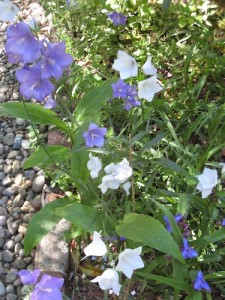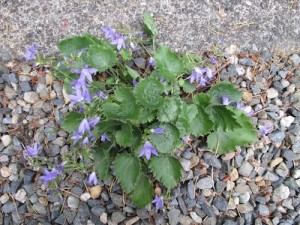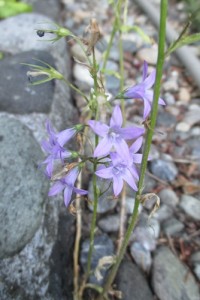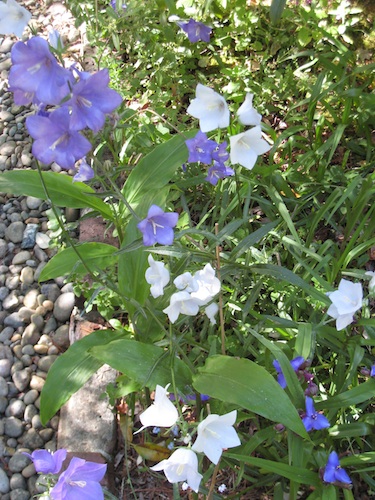(Click on any image to get a larger view)

.
.
.
.
Edible Bellflowers
Campanula species
CAMPANULACEÆ; Bellflower Family
The English name bellflower is applied to many plants. As used in this article, the focus is on the 300 to 425 species of genus Campanula.
In Latin, campana means bell. Campanula flowers are shaped more or less like little bells. The genus grows mainly in the northern hemisphere, most abundant from the Mediterranean region to the Caucasus mountains; it extends even to some tropical mountains. The genus consists of annuals, biennials, perennials, and monocarpic plants.
Gardeners have long cherished many species as ornamentals, for their lovely bell-shaped flowers. Nearly all species bear blue or white flowers; extremely few have yellow flowers. Fragrance is scarce (such as clove-scented Campanula versicolor Andrews).

A few species are weedy (notably Campanula rapunculoides L.); many are easily grown in ordinary garden conditions; some require specialized rock garden habitats. One species has been much cultivated as a houseplant (Campanula isophylla Moretti), and seven others used so sparingly.
A few species have been grown as vegetables, and many others are eaten from the wild. In general, the genus is non-toxic, and flowers, foliage and roots are bland flavored and edible. Many species ooze a harmless sticky white sap.
Other genera related to Campanula that contain edible species include: Adenophora, Azorina, Canarina, Codonopsis, Legousia, Petromarula, Phyteuma, Platycodon, Trachelium, and Wahlenbergia.
Below are listed those 25 species I have found reported as having been eaten — or eaten myself. Certainly others exist; also, on some where only the leaves may be cited, surely the flowers are also edible.

Campanula alliariifolia Willd (Cornish Bellflower, Ivory Bells); Leaves, flowers.
Campanula carpatica Jacq. (Carpathian or Tussock Bellflower); Leaves, flowers.
Campanula cochleariifolia Lam. (Fairies Thimbles); Leaves, flowers.
Campanula Cymbalaria Sm.; Leaves, roots.
Campanula edulis Forssk.; Roots.
Campanula fenestrellata Feer; Leaves, flowers.
Campanula garganica Ten. (Adriatic Bellflower); Leaves, flowers.
Campanula glomerata L. (Clustered Bellflower); Leaves, flowers, roots.
Campanula grandis Fisch. & C.A. Mey. = C. latiloba C. DC. (Great or Delphinium Bellflower); Leaves, flowers.
Campanula lasiocarpa Cham. (Alpine, Mt. or Alaska Harebell); Stems.
Campanula latifolia L. (Giant or Broad-leaved Bellflower); Young shoots.
Campanula lyrata Lam.; Edible greens.
Campanula Medium L. (Canterbury Bells); Leaves, flowers, roots.
Campanula pelviformis Lam.; Part unspecified, eaten in the Balkans and E Mediterranean islands.
Campanula persicifolia L. (Peachleaf or Willow Bellflower); Leaves, flowers.
Campanula Portenschlagiana Schult. (Dalmatian or Adria Bellflower); Leaves, flowers.
Campanula Poscharskyana Degen (Serbian or Trailing Bellflower); Leaves.
Campanula punctata Lam. = C. takesimana Nakai (Spotted or Korean Bellflower. Chinese Rampion); Leaves, flowers, roots.
Campanula pyramidalis L. (Chimney Bellflower); Leaves, flowers, roots.
Campanula rapunculoides L. (Creeping or Roving Bellflower); Leaves, flowers, roots.
Campanula Rapunculus L. (Rampion); Leaves, flowers, roots.
Campanula rotundifolia L. (Harebell, Bluebell); Leaves.
Campanula thyrsoides L. (Yellow Bellflower); Young stems.
Campanula Trachelium L. (Nettle-leaved Bellflower, Giant or Great Throatwort, Bats in the Belfry); Leaves, roots.
Campanula versicolor Andrews (Various-colored Bellflower); Leaves, flowers.
_______________________________
About Arthur Lee Jacobson
 A lifelong Seattle resident, Arthur developed a passion for plants at 17 and has made his living growing, photographing, and writing about plants. He is a rare expert who can speak about wild plants, garden plants, and house plants.
A lifelong Seattle resident, Arthur developed a passion for plants at 17 and has made his living growing, photographing, and writing about plants. He is a rare expert who can speak about wild plants, garden plants, and house plants.
Arthur has a special interest in edible plants, and, in his field guide Wild Plants of Greater Seattle, he includes comments on the edibility, taste, and uses of plants found in the city.
For more information, visit Arthur Lee Jacobson’s website.
Photos © Arthur Lee Jacobson


Yes, as stated above: leaves, flowers and roots. Bland flavored.
Can you eat the rpucluoides species? I have some growing in my backyard and am a bit curious